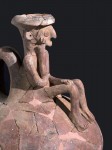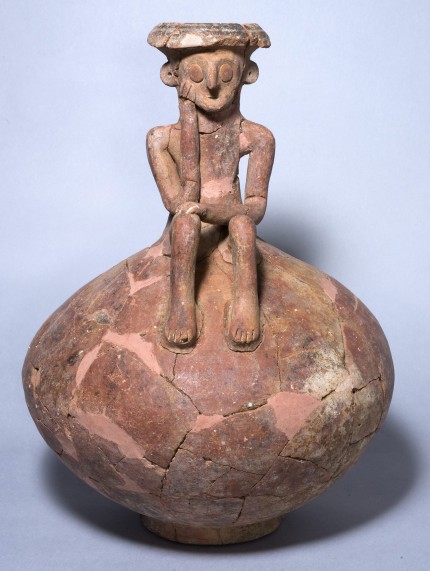 An excavation in Yehud, Israel, prior to construction of new housing has unearthed a unique ancient pottery jug topped with a figurine in a reflective posture reminiscent of Rodin’s “The Thinker.” The clay vessel was discovered on the last day of the dig by a team of professional archaeologists from the Israel Antiquities Authority and very fortunate high school students in an archaeology-themed matriculation stream. It was one of several artifacts and remains — daggers, arrowheads, an axe head, sheep bones and the bones of another animal, probably a donkey — found with the jug. Archaeologists believe at least some of these were funerary offerings for a prominent individual, and an extraordinarily rich array of grave goods at that.
An excavation in Yehud, Israel, prior to construction of new housing has unearthed a unique ancient pottery jug topped with a figurine in a reflective posture reminiscent of Rodin’s “The Thinker.” The clay vessel was discovered on the last day of the dig by a team of professional archaeologists from the Israel Antiquities Authority and very fortunate high school students in an archaeology-themed matriculation stream. It was one of several artifacts and remains — daggers, arrowheads, an axe head, sheep bones and the bones of another animal, probably a donkey — found with the jug. Archaeologists believe at least some of these were funerary offerings for a prominent individual, and an extraordinarily rich array of grave goods at that.
 The pot-bellied jug with a spigot on one side of the neck is of a shape and style common to the Middle Bronze Age period about 3,800 years ago, but the figurine attached to the neck is one of a kind. Nothing like it has been found before. The figurine appears to have been added after the basic vessel was complete. Archaeologists aren’t sure if the same potter who made the jug also created the figurine. It’s possible a second artisan created it, using the neck of the jug as the torso of the figure and then adding the arms, leg and face.
The pot-bellied jug with a spigot on one side of the neck is of a shape and style common to the Middle Bronze Age period about 3,800 years ago, but the figurine attached to the neck is one of a kind. Nothing like it has been found before. The figurine appears to have been added after the basic vessel was complete. Archaeologists aren’t sure if the same potter who made the jug also created the figurine. It’s possible a second artisan created it, using the neck of the jug as the torso of the figure and then adding the arms, leg and face.
The figure sits on top of the jug, his knees bent and left arm crossing both knees. His right arm is bent, elbow behind the other arm on his knee, his hand holding his chin as if he is deep in thought. The degree of detail is exceptional and very unusual for pottery of the period.

The students who got to see this charming figure excavated are thrilled.
“Suddenly I saw many archaeologists and important people arriving who were examining and admiring something that was uncovered in the ground” recalls Ronnie Krisher, a pupil in the Land of Israel and Archaeology stream in the Roeh religious girls high school in Ramat Gan. “They immediately called all of us to look at the amazing statuette and explained to us that this is an extremely rare discovery and one that is not encountered every day. It is exciting to be part of an excavation whose artifacts will be displayed in the museum”.